Varieties of tiles and nuances of choice

Ceramic tiles are made from clay and quartz sand by firing. Currently, depending on the production technology, there are many types of tile coverings. In this article, we will consider the popular types of tiles and the nuances of their choice.


Peculiarities
Like any wall covering, floor tiles have a number of positive and negative qualities. It is necessary to familiarize yourself with them before deciding on the acquisition of material.
Among the advantages, chemical resistance is distinguished. The appearance of the tiles does not change under the influence of chemicals such as salts, acids and household substances. When cladding the walls of a bathroom or kitchen, it is necessary to remember this characteristic of the coating. The tile is also immune to pool chemicals, so builders advise lining the bowl with this material.




Wear resistance and the ability to withstand mechanical stress are distinguished by the tiled coating. The enamel-free surface resists abrasion well, and the enamelled one retains its appearance for a long time. It is important to consider the ultimate tensile strength, compressive strength and especially bending. The mechanical characteristics depend on the degree of water absorption by the material. The thickness of the tiles must be chosen based on the functional area of the room.



Due to the ability of tiles to resist the corrosive effects of water and air saturated with moisture, this material has become widely used for cladding pools and bathrooms. Ceramics are practical because they do not require special maintenance. With proper installation, the coating will not lose its performance during wet cleaning.
A wide range of color palettes allows you to create any design. Thanks to the ease of maintenance of ceramics, walls and floors can be laid out not only in the bathroom. Also, the tiles have a wide range of sizes, which helps to create a memorable interior.



Apart from its advantages, ceramics also have some disadvantages. The main disadvantage is the complexity of installation. According to European-quality repair standards, the joints must be even, strictly horizontal and vertical. Each seam must be treated with a special grout.
During operation, the grout may darken, there are frequent cases of the appearance of fungus or mold. The solution to the problem is thorough care and regular treatment with special antiseptics. Increasing the size of the tiles will significantly reduce the number of joints.




Views
For flooring, it is important to take into account the ability of the material to withstand mechanical stress. It is important not to forget about the slip resistance of the tiles. Ceramic wall tiles are usually mosaic tiles in different shades. There are several types of cladding:
- Pressed. The manufacturing technology of this material is rather complicated. The special powder is compacted under a press. The color of the original mix affects the color of the final material. Such tiles are highly impact resistant. Its wear resistance can be increased by reinforcement. Pressed mosaic is more suitable for decorating pedestrian paths in a suburban area, since its strength is not inferior in reliability to asphalt pavement.



- Glazed tiles. The fragments are covered with a layer of colored glass, which increases the hardness and moisture resistance of the material. Pouring creates a special shine and unusual pattern, which is why such facing ceramics have gained wide popularity in the building materials market. Depending on the composition of the glaze and the firing time, the gloss can be either transparent glossy or translucent with a colored pigment. The product is used for the installation of swimming pools.

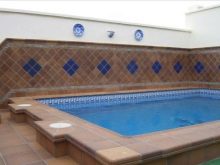

- Porcelain stoneware or tile. It is obtained by the method of semi-dry pressing of a raw mixture of white clay at high pressure and temperatures from 1200 to 1300 degrees. A special manufacturing technology allows you to create a coating with zero water absorption, which is well suited for both interior cladding of a room and for finishing the facades of a building. Designers note a wide range of textures for natural stone coatings: you can purchase tiles with a relief or with a surface polished to a shine. It is important to know that porcelain stoneware can only be laid on a special adhesive.
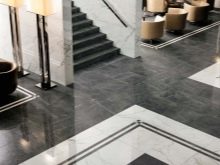


- Fireclay tiles. This material is used in the construction of stoves and fireplaces, because the material is resistant to strong temperature changes. The coating is considered to be quite expensive because it is created by hand. The addition of stone flour provides refractoriness and the ability to withstand prolonged static loads. Furnaces faced with such tiles do not require additional insulation.
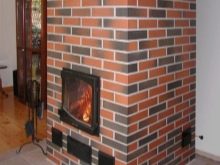


- Cork tiles It is made from layers of suberin, several types of resins and a finishing surface. A children's room lined with cork is an excellent solution, because the main advantage of the material is its natural origin and hypoallergenicity. Due to its high thermal insulation, such parquet is suitable for the living room of an apartment building in the northern regions, allowing you to reduce heating costs.


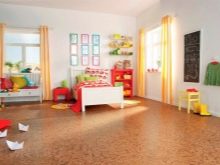
- Styrofoam panels are considered the most affordable and inexpensive. The material is used as a decoration for a room during a rough renovation of an apartment. Wall foam tiles are used much less often than ceiling tiles. The peculiarity of the coating is ease of installation and a wide choice of textures. The mosaic can be painted in any color, but it is recommended to pre-test the paint on a test piece.



Dimensions (edit)
The tile has a large range of sizes and a variety of shapes. Typical shapes are a quadrilateral, but in some design solutions, you can find complex geometry shapes with multiple faces. The choice of the appropriate size and model depends on the purpose of the tile.
The interior cladding is made of glazed tiles. The fragments should be up to three millimeters thick. It is allowed to use a small number of parts with a lower thickness. The choice of tile size depends on the size of the room. Wide walls allow you to place mosaics of any size and configuration: a large image, laid out of small details, will look beneficial.


When choosing finishes for small spaces, preference should be given to medium-sized panels. The length of the part should not exceed twenty centimeters. The width can vary from 20 to 40 cm. You can visually increase the space by using rectangular tiles. The location of the fragments with the larger side horizontally will visually lengthen the walls, and the vertical orientation will "stretch" the ceiling.
The exterior cladding of the facades is made of glazed tiles with a corrugated back surface. The thickness of the elements ranges from 4 to 9 mm. Wide slabs are easy to install and reduce the number of butt joints. The facade coating is regularly exposed to aggressive environmental influences, therefore, a small number of joint joints will reduce the time spent on their processing with a protective agent.

Floor tiles should be up to 13 millimeters thick. Compaction of the coating is necessary to increase its thermal conductivity.Choosing the right tile size for a miniature room can be difficult: too small details can significantly reduce the space, the same effect can be obtained by choosing too large panels.

Colors
Designers offer a variety of color options for laying tiles. The most common options are a dark bottom stripe and a light masonry top. To visually expand the space, the tones are separated by a border. Monochromatic fragments become dominant elements, however, designers identify several ways for those who want to deviate from the usual solutions.



Chess masonry looks beneficial both in a traditional black and white palette and in a multi-colored variation. The alternation of bright tiles with light ones looks interesting. It is important to remember that the colors must match and look easy. Red mosaic looks harmonious in combination with pale pink or pale yellow. When installing ceramics in a staggered manner, bending of the seams should be avoided: this will lead to a distortion of the space.

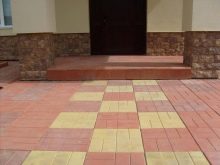

Gradient - one of the most interesting and non-standard solutions of modern design. The transition effect can be obtained using both large panels and small tiles. The more intermediate shades are used, the softer the color transition. Such laying requires painstaking work already at the stage of selecting a suitable tone. Blue paint, flowing into dark blue, will look good in the bathroom.


The floor covering of a large room can be laid out as "carpet"... The scheme is simple - the center is highlighted with tiles of a different color, repeating the contour of the room. You can diversify the drawing by repeating this technique. The alternation of light and dark material looks competently. However, this layout is not recommended to be repeated on walls or ceilings: multi-colored mosaics can cause fatigue.
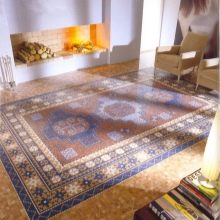


To achieve a spectacular picture, designers are advised to turn to technology. patchwork... Composing combinations of pieces with different patterns, but the same size - an ethnic style solution. It is customary to completely cover the floor and partly the walls with decor. Such a bright accent should not be combined with flashy colors or additional ornament. An orange or light green wall will "argue" with the mosaic, while a white one, on the contrary, will highlight the pattern.



Kaleidoscope - a colorful version, assuming a chaotic arrangement of color spots. The spots can consist of a single fragment or of several slabs. In this way, you can decorate the most illuminated wall, and leave the rest unicolored. An interesting solution would be to use shiny materials. Gold tiles in the interior look more profitable if they are supported by small elements of the appropriate shade.



Another common, but quite interesting solution is mosaic panel with the finished image... A ceramic panel must be placed on a free wall. The perimeter of the picture is separated by a border of contrasting tiles, imitating a frame. An interesting effect will be obtained if you place a large mirror on the opposite wall. With the help of a properly selected image, you can visually change the size of the room: a road going into the thicket of a forest or a sunset on the coast visually increase the space.




The tiles can be combined with decorative plaster. The lower part of the wall is covered with ceramic masonry or the contour of plumbing fixtures follows it. The rest of the surface is painted. The key rule is that the tiles should be located slightly above the level of the sink. This approach will protect the surface from excess moisture.



Specifications
In order to select a reliable coating that can withstand all operating conditions, it is necessary to take into account the chemical composition of the material. Physical and mechanical characteristics depend on the ratio of the components.In the manufacture of ceramic tiles, a special mixture of chemical reagents is used. Charge mass - raw powder for the formation of cladding. It includes components of the following main groups:
- Kaolin. A mixture of different types of clays or a homogeneous material. Its presence ensures the plasticity of the composition during tile molding. The mineral kaolinite, of which kaolin is composed, is white in color, therefore the final material acquires a light shade without the addition of pigments.


- Quartz sand. It is sometimes replaced with crushed granite. This material is structural because it forms the skeleton of the product. The framework hardens during drying and resists loss of shape and dimensional changes during drying.
- The required viscosity is achieved by adding feldspar and carbonates... These components provide a high product density. When selecting a material, one should avoid replacing the necessary components with artificial analogs: this can significantly affect performance.
- Glaze and dyes added to obtain the desired color and texture.


Different manufacturers may differ in the ratio of components and their quantity. However, the manufacturing techniques remain unchanged. When selecting a material, mechanical properties must be taken into account. Among the leading strength qualities, it is necessary to highlight the following:
- Ultimate static bending force. The material is pre-tested for a given load, which the tile must withstand until failure. The greater the thickness of the product, the higher the bending resistance. The linear dimensions are inversely proportional to the dimensions of the fragment.


- Compressive strength. The indicator of the maximum static load that the product can withstand until the first damage occurs. This mechanical characteristic increases linearly with increasing density. These values are determined only in the laboratory.
- Wear resistance. This indicator is important to consider when choosing a floor covering. Classes of the surface's ability to withstand impact and scratching are determined on the Mohs scale from 1 to 10. The first and second class are installed in the bathroom and toilet, and the third - in the kitchen and other rooms.


The density of the tiles is related to the mechanical characteristics. There are three types of density: true, relative and average. To assess the quality of the coating, the average density is used, equal to the ratio of kg mass to m3 volume. Thermal conductivity, water absorption capacity, and porosity are inversely related to density. The high strength of the product and its weight are due to its high density.



In appearance, several types of surface are distinguished:
- Matt. To obtain such a coating, the finished product is not coated with glaze. The tile looks raw, which is great for cladding building facades. The coating is more durable than its glossy counterparts and can withstand any cleaning.
- Polished surface obtained by processing a cut matte surface. The main disadvantage of the material is its susceptibility to scratching. The tile requires careful maintenance and care during the installation process. The mosaic becomes slippery when it comes into contact with water, which is unsafe.



- Semi-polished. Partial removal of the matt surface with sanding takes place. The soft gradation of the polished and untreated part looks avant-garde. Also, this kind of partial processing improves the mechanical properties of the product. Floors tiled with such a coating are less dangerous than lacquered counterparts.
- Waxed mosaic. Before firing, the surface is covered with mineral particles, which give the coating a pearlescent effect. Crystals reduce the sliding moment or completely eliminate it. Also, spraying increases the wear resistance of the plates.
- Reclaimed tiles. The manufacturing technology is similar to the creation of a polished surface. The edges of the fragments are cut strictly at right angles so that the seams are not noticeable when laying. Such a mosaic looks like a single surface without joints.



Style and design
Designers advise to discard stereotypes about the use of tiled coverings exclusively for cladding surfaces in the bathroom or toilet. The mosaic looks luxurious both in the living room and in the bedroom. It is only important to correctly select the texture of the material.
Tiles imitating the surface of natural stone or semi-antique are widely used. The surface of such ceramics is embossed, which makes it possible to use it as floor decor in apartments. Stylizing ceramics like marble will make the look luxurious, but not pretentious. So that the masonry does not seem artificial, the tiles are advised to be combined with open space. A smart solution is to lay a porcelain stoneware path in the garden.
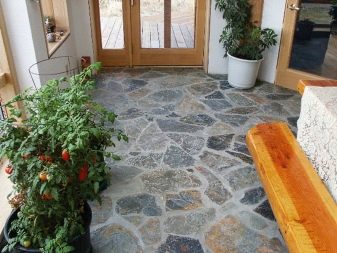



In order for the imitation of stone to look appropriate in the bedroom or living room, designers recommend complementing the interior with decor with a predominance of metal or cast iron elements. Laconic strict colors and pieces of furniture with sharp edges will complete the picture. For rooms with excessive moisture, ceramics will become a real salvation due to their increased density and good moisture resistance.
The creation of pebble floor and wall tiles has become a real boon for lovers of the marine theme. The original ceramic cladding panels do not differ in appearance from their natural counterpart, but they have a number of special properties. Some samples contain inclusions of glass and natural stones on a clay base. Other craftsmen offer a one-piece version of a pebble mosaic.




The coating is excellent for cladding a balcony or terrace. Despite the complexity of the design, the material also resists corrosion well and is able to withstand critical temperature changes, like a solid porcelain stoneware coating. Tiles are produced in various shapes and textures, which allows you to create a unique design. Among the positive qualities, the massage properties of "pebbles" should be noted.
Wood is widely used in interior design. However, the microclimate of the room or the rough covering will not always allow laying wooden parquet. Recently, plywood-like ceramic tiles have appeared on the market. The material completely imitates the texture of wood, but does not require special laying conditions. The wood pattern is applied to both simple ceramics and porcelain stoneware.


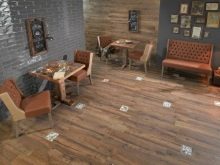
Wood-look tiles can be laid in a variety of ways. The most popular ones are:
- Staggered masonry view use if the floor is to resemble the deck of a ship. The adjacent row of panels is laid with a shift of 1/5 or 1/6 of the fragment. It is not recommended to increase whether or not to change the masonry step. Such masonry also looks harmonious with the diagonal arrangement of the slabs.

- Herringbone masonry known to many and can be lined both straight and diagonally. The rough surface must first be marked out to avoid skewing. "Herringbone" looks well when combining colors of the same tone or sharply contrasting with each other. Suitable for residential and office environments. The pattern can be complicated with tiles of a complementary color or other texture.
- Chess masonry with an offset, it will visually lengthen the space, but, as in the case of the first method, it is not recommended to change the step. The options for such masonry are varied: the cells are filled with several panels of the same color or a repeating pattern. You can combine different types of tiles or mix patterned fragments with inserts of solid color tiles.

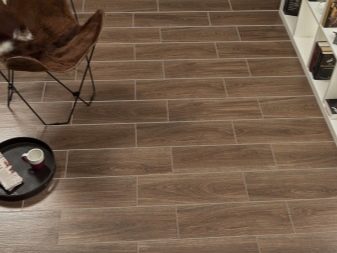
The surface of the tile can be polished or embossed. The repeating contours on the tiles are becoming all the rage.The protruding pattern not only adds luxury to the interior, but is also able to visually correct some of the unevenness of the installation. A wave extending on the wall of the room allows some deviation of the seams. For novice craftsmen, tiles with voluminous ornate patterns will be a real boon.


- Embossed masonry helps tactile orientation for people with low vision. Models with special identification patterns can be ordered. Such tiles are already used in public buildings in some European countries. Some craftsmen are aware of hand tiles, which are very popular due to their uniqueness and limited edition. A pattern of complex geometric shapes or flowers is often applied to such a coating.



How to choose a tile?
The competent choice of a suitable cladding depends on taking into account all the characteristics of the rough surface. The size and shape of the room and its microclimate have a great influence. Structural elements, such as arched or beam structures, can significantly complicate installation.
To get a good ceiling or wall tile, there are a few things to consider:
- The glaze should cover the entire fragment, including the back-side runs. Uncoated surfaces stand out from the background. The natural color of the clay is practically not covered with grout, which significantly affects the perception of the final work.
- The tiles are produced in batches. The granulometric composition of each of them may differ slightly. But even such a small discrepancy is reflected in the color of the material. Builders advise to choose panels from the same batch to avoid such misunderstandings.

- It is better to take ceramics with a margin of about 5 or 7 percent of the total amount of material. This safety stock will be used for trimming. When choosing tiles with a glossy surface, the consumption can be increased. Mirror coatings can be scratched when installing or transporting tiles.
- To obtain complete harmony in the interior, you should purchase cladding from one collection. Many manufacturers produce floor and wall kits in the same color or style. This approach helps to reduce the time required to select the material of the desired shade or texture. The same technique is used when buying patchwork tiles. Pattern sets are gaining more and more popularity.

- The type of tile is indicated by the color on the packaging with the material. The first grade corresponds to red. The lower the number, the better the quality. Coatings of the second grade are marked with blue, and the third grade is marked with green. The mechanical characteristics of each grade should be consulted in advance. If the rough room is characterized by high humidity or critical temperature drops, then the best option would be a coating with a red marking.
- The tiles must not absorb moisture. The liquid collects on the surface of a quality material in drops. If the coating comes into contact with water, then it is necessary to check the elements for moisture resistance.

Influence of the place of laying
Tiles for different functional areas can vary significantly in terms of their requirements. It is necessary to take into account the characteristics of the room.
Porch cladding must be able to withstand low temperatures. Immunity to aggressive environments and external physical influences is important. It is forbidden to lay glazed tiles on the steps. Smooth material is traumatic, as it does not provide the necessary adhesion of the shoe to the surface. This should be especially taken into account by families with children.
The best solution for facing a porch or paths would be a matte stone with a rough texture. The more complex and deeper the drawing, the greater the grip. It is important to remember about possible precipitation in the form of rain and snow, which reduces the safety of the coating.




Glaze is not recommended for use in the hallway for similar reasons.The surface should look softer, but retain its strength characteristics. You should not buy material in light colors: due to the high traffic intensity and constant contact with the street, the light coating will quickly wear out.
The kitchen floor must be protected against chemical detergents. The coating should be easy to clean and have high durability if the landlords love to cook. It is better to choose a slightly rough surface to ensure safety. The ideal solution would be a tile with a pattern that masks unwanted stains.



The tiles in the bathroom must have high protection against moisture and corrosion. The surface must not slip. If the room is small, then preference should be given to the coating of a light shade.


Tips & Tricks
The rough surface must be washed and covered with a moisture-resistant compound. This can be a layer of waterproof plywood or a spray of a special chemical composition. The base must be well leveled: this can be done by applying a thin layer of a quick-drying self-leveling compound. In order to have a good idea of the further installation of tiles of different colors or a complex pattern, the mosaic can be laid out on a prepared surface and marked.
To maintain the same distance between the fragments, plastic crosses are inserted into the seams. After the glue or cement, on which the tiles are fixed, has dried, the gaps are filled with a special protective compound. The evenness of the masonry must be checked during the installation of the coating. Until the base is frozen, it is not difficult to make adjustments.


To ensure the safety of the mosaic covering for a long time, careful and timely maintenance is required. Mechanical cleaning should be carried out taking into account the characteristics of the coating. It is enough to treat the polished surfaces with a cloth soaked in a special solution. It is forbidden to rub the surface with metal sponges. You can also use glass cleaner for cleaning.

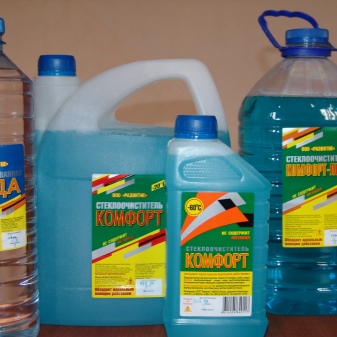
It is recommended to treat the tiles with antiseptics that resist the development of mold. Such funds must be carefully rubbed into the seams, and the excess is removed with cloth napkins. Work must be carried out with rubber gloves. The grout between the tiles is corrected if necessary. Do not allow cavities to form - this can lead to the appearance of fungus.
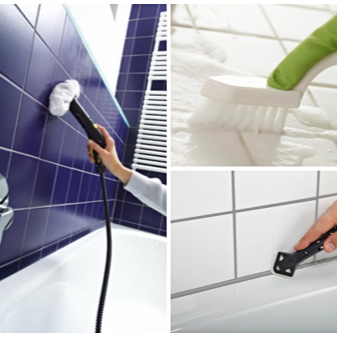

Manufacturers and reviews
When talking about the purchased product, buyers note the quality of the Belarusian tiles. Ceramics from Belarus meets all the requirements of consumers: tiles "Quadro" have high strength, durability and moisture resistance. After a year of operation, no mechanical damage was found on the surface of the mosaic. The glossy surface, despite consumer concerns, remains clean. There is no need to buy a matte surface just for fear of stains.
Tile Cerrol Porto Tall Ship produces a series of collections with printed photographs. This style is perfect for decorating the interior of a spacious bathroom. Customers appreciate the quality of the image and the sharpness of the print. However, the size of the images does not always look appropriate in small rooms.

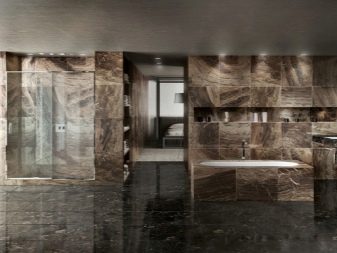
Company Rex presents a wide selection of high-strength porcelain stoneware tiles, a wide range of antique finishes, natural stone and wood. Each collection contains several types of coatings that can be combined well.
CIR Serenissima - Italian coating. Consumers note a wide selection of materials for facing the porch and garden area. This is a great imitation of sidewalk wear. The material is reliable and easy to use.


Customers also recommend tiles Vallelunga Pietre dei consoli... The coating maintains its operational properties for many years, it is easy to clean and comfortable to use.Buyers note pleasant shades and a matte finish.
Another Italian brand - Naxos, also pleases its customers with a high-quality porcelain stoneware coating. The company produces carpet-patterned tiles that can be used to add coziness to a bedroom or living room. The series consists of rectangular tiles. Such fragments are much easier to lay than square counterparts.
Tile Ceracasa from Spanish manufacturers made of environmentally friendly material. Customers celebrate its glamorous shades and chic shine that grabs attention. However, the floor is too slippery and therefore not suitable for placement on the floor.



Spanish company Gayafores produces quality tiles, but it costs enough. Buyers note that during operation, the coating retains heat even in the coolest room. The cost of purchasing this material is fully justified and pays off. In addition, the tiles are distinguished by their design with interesting patterns.
Ceramic tile Fanal produces a wide range of collections with the image of small mosaics. This option is suitable for someone who does not want to spend too much time on work, but wants to get a small, neat drawing. The high quality finish is easy to clean and does not require any special surface treatment.
Spanish porcelain stoneware from the company Roca perfect for bedroom or nursery decor. The company launches a line of flooring with floral motifs in a romantic style. Buyers note the delicate shades and noble shine of the coating.


The products of Portuguese manufacturers perfectly protect the house from dampness and mold. Customers celebrate the striking patterns and intricate designs on the ceramic stone. It is no coincidence that there is a tile museum in this country: this material has a long history in Portugal.


Beautiful examples and stylish options
In the interior, there are few ways to arrange tile fragments, so the designers put all the emphasis on choosing the right color combination. Below are some of the options for tiled masonry in the interior of modern rooms.

In the room, the elements are mirrored opposite each other. Tile masonry seams form perpendicular lines. Their direction follows the geometry of the room - this is the most convenient way to control the styling. This method is called "seam in seam". The repetition of the pattern along the dark strip of masonry makes an exclusive bathroom. If it is not possible to create a gradient, this technique is used to soften the edges and connect the dark spot with the light background.

Brown ceramic tiles are combined with wood furnishings for a complete look. The combination of a glossy surface with matte tiles creates interesting light transitions.


A vibrant combination of pink mosaic and patterned elements is the key to creating a trendy bathroom. To make the interior "breathe", the walls are complemented with white. Ornamental tile inserts are a classic patchwork technique. With this masonry, accent stripes are created. In addition to the universal bath, the bowl is decorated with neutral peach slabs.

To maintain the classic style of the space, the paving features plant motifs. Pink is in perfect harmony with the rest of the colors, without interrupting them. Large windows fill the rooms with light. White plaster perfectly reflects glare from varnish coatings, visually enlarging the room. Stylish accessories and an intricately shaped vase emphasize the exclusivity of the interior.

The bas-relief coating allows you to create a complex design in a simple small-sized room. Such solutions are performed exclusively in light colors: white, gray, all shades of pastel colors. Otherwise, the pattern will sink, and the room will visually decrease.

To make the room not look like a hospital room, the designers place dark color accents - pieces of furniture and household items.An intricate wave pattern continuously extends across the entire space of the room. This is necessary for the visual lengthening of the room and compliance with the composition.

The room becomes airy and light, and the convex ornament does not make perception heavier. In some places there may be inconsistencies in the joints of the seams, but this will not be noticeable due to the total mass of the pattern. Black floor tiles contrast sharply with the color of the wave, so a black stripe is laid on the opposite wall. This effect helps to give the interior harmony and clarity of forms. The tiles perfectly outline the walls, following the contour of the room.


The marine theme can be used not only when decorating a bathroom or a country house. Natural motifs are perfect for a living room interior in a metropolis. The rounded, flake-like tiles add a fresh note. An unusual color transition from dark at the base of the wall to blue at the ceiling is striking. Some cells are left empty for a reason: thanks to the gaps, large masonry does not look bulky.

To make tiles the dominant part of the interior, simple furniture in neutral tones is selected. The multi-colored ornament favorably complements the minimalist sofa, simple in geometry. The accent color on the cushions maintains the color of the walls and completes the look. The floors are made of wood grain panels. The masonry of the floor differs from the pattern of the walls, which creates a contrast of planes.
How to choose a tile, see the video below.













The comment was sent successfully.